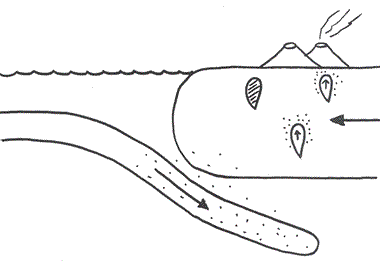Teaching Plate Tectonics with
Easy-to-Draw Illustrations
| Teaching Plate Tectonics | |||

The next time you teach plate tectonics, consider a draw-with-me presentation that will engage your students and help them understand the spatial and movement aspects of plate boundary environments.
The process of drawing a picture involves students much more deeply than reading or discussion. This is because drawing gives students an opportunity to visualize sizes, shapes, motions, and spatial relationships. Important facts can be added through annotations and captions. Students remember best when they see and do!
Many students find a draw-with-me presentation an enjoyable experience. Drawing enhances their learning, understanding, and retention processes. And, at the end of the class session, they have a set of illustrations that can be used for study, reference, and communication purposes.
I have used the illustrations on these pages (see menus at page top and bottom), with only minor modifications, to lead students from primary grades through graduate school in lessons about plate tectonics, volcanoes, earthquakes, and the rock cycle. When time allows, I always opt to draw these illustrations step-by-step with my students. It’s fun that way!
When time is short, presenting pre-drawn illustrations on an overhead projector can be a good alternative. With this methods you start with a basic drawing and then annotate it with important features. This works best when your students have photocopies of the illustrations to which they can add important details and annotations.
For your convenience, starting point drawings of all illustrations used in this lesson are included in my Plate Tectonics Guidebook . Please feel free to use these illustrations in any way that will enhance your teaching. And, if you have time, draw them once for me.
The process of drawing a picture involves students much more deeply than reading or discussion. This is because drawing gives students an opportunity to visualize sizes, shapes, motions, and spatial relationships. Important facts can be added through annotations and captions. Students remember best when they see and do!
Many students find a draw-with-me presentation an enjoyable experience. Drawing enhances their learning, understanding, and retention processes. And, at the end of the class session, they have a set of illustrations that can be used for study, reference, and communication purposes.
I have used the illustrations on these pages (see menus at page top and bottom), with only minor modifications, to lead students from primary grades through graduate school in lessons about plate tectonics, volcanoes, earthquakes, and the rock cycle. When time allows, I always opt to draw these illustrations step-by-step with my students. It’s fun that way!
When time is short, presenting pre-drawn illustrations on an overhead projector can be a good alternative. With this methods you start with a basic drawing and then annotate it with important features. This works best when your students have photocopies of the illustrations to which they can add important details and annotations.
For your convenience, starting point drawings of all illustrations used in this lesson are included in my Plate Tectonics Guidebook . Please feel free to use these illustrations in any way that will enhance your teaching. And, if you have time, draw them once for me.
Hobart M. King
Publisher, Geology.com
Tidak ada komentar:
Posting Komentar
Bagaimana komentar Anda?